- Essay Writing MCQs
Important Essay Writing MCQs. All of these are types of essays, except? (A). Narrative essay (B). Personal essay (C). Argumentative essay (D). Descriptive essay (E). None of these Answer: b The introductory paragraph of an essay requires the topic, thesis and (A). main ideas (B). supporting details (C). both a and b (D). a and b (E). None of these Answer: a An essay is a (A). song with a novel or a story (B). poem that has multiple stanzas (C). some kind of writing that has organized paragraphs (D). some kind of writing that requires research (E). None of these Answer: c Which of the following essays describes a subject? (A). Narrative essays (B). Reflective essays (C). Argumentative essays (D). Expository essays (E). None of these Answer: d A good essay has the characteristics except? (A). Fakeness (B). Dignified style (C). Brevity (D). Personal touch (E). None of these Answer: a Which of the following is the essay that uses to increase the imagery of the setting? The five senses means the sense of taste, sound, touch, smell, and sight. (A). Narrative essays (B). Expository essays (C). Descriptive essays (D). Argumentative essays (E). None of these Answer: c Which of the following essay tells a Story? (A). Argumentative essay (B). Descriptive essay (C). Reflective essay (D). Narrative essay (E). None of these Answer: d We can write a short or long essay. (A). True (B). False (E). None of these Answer: a Which of the followings essays are a set of one’s thoughts. (A). Reflective (B). Expository (C). Argumentative (D). Narrative (E). None of these Answer: a A good write must avoid in a good essay? (A). Brevity (B). Dignified words (C). Slang (D). Unity (E). None of these Answer: c Descriptive essays explains a person or a place. (A). True (B). False (E). None of these Answer: a The writer concludes by logical reasoning in ____ essays. (A). Narrative essays (B). Reflective essays (C). Argumentative essays (D). Descriptive essays (E). None of these Answer: c
Narrative Essay MCQs
100+ Essays examples

Read More MCQs on Technical Report Writing
- Important MCQs of Technical Report Writing
- Letter Writing and Drafting MCQs
- Types of Letters MCQs
- Internet and Email MCQs
- Parts Of Business Letter MCQs
- Repeated MCQs of Technical Report Writing
- CV or Resume Writing MCQs
- Cover Letter MCQs
- Application Writing MCQs
- Discovering and Planning MCQs
- Purpose, Thesis, and Audience MCQs
- Revising, Editing, and Proofreading MCQs
- Collaborative writing MCQs
Research Topics on Technical and Business Report writing
Useful tutorials on report writing.
- Types of Report Writing
- Types of Content Writing
- Application for Fee Concession
- Examples of Report Writing on an Event
- How to Write a memo (Memorandum)?
- How to Write a Vision Statement?
- How to Write Mission Statement?
- How to Write Goals and Objectives Statement?
Related Posts:
- Tips on Writing a Good Essay: Valuable Information for The Student
- Technical Report Writing Multiple Choice Questions MCQs
- Technical Report Writing Solved MCQs
- Memos MCQs in Technical Business Writing
- Letter Writing and Drafting MCQs
You must be logged in to post a comment.
Have a language expert improve your writing
Run a free plagiarism check in 10 minutes, generate accurate citations for free.
- Knowledge Base
- The four main types of essay | Quick guide with examples
The Four Main Types of Essay | Quick Guide with Examples
Published on September 4, 2020 by Jack Caulfield . Revised on July 23, 2023.
An essay is a focused piece of writing designed to inform or persuade. There are many different types of essay, but they are often defined in four categories: argumentative, expository, narrative, and descriptive essays.
Argumentative and expository essays are focused on conveying information and making clear points, while narrative and descriptive essays are about exercising creativity and writing in an interesting way. At university level, argumentative essays are the most common type.
In high school and college, you will also often have to write textual analysis essays, which test your skills in close reading and interpretation.
Instantly correct all language mistakes in your text
Upload your document to correct all your mistakes in minutes

Table of contents
Argumentative essays, expository essays, narrative essays, descriptive essays, textual analysis essays, other interesting articles, frequently asked questions about types of essays.
An argumentative essay presents an extended, evidence-based argument. It requires a strong thesis statement —a clearly defined stance on your topic. Your aim is to convince the reader of your thesis using evidence (such as quotations ) and analysis.
Argumentative essays test your ability to research and present your own position on a topic. This is the most common type of essay at college level—most papers you write will involve some kind of argumentation.
The essay is divided into an introduction, body, and conclusion:
- The introduction provides your topic and thesis statement
- The body presents your evidence and arguments
- The conclusion summarizes your argument and emphasizes its importance
The example below is a paragraph from the body of an argumentative essay about the effects of the internet on education. Mouse over it to learn more.
A common frustration for teachers is students’ use of Wikipedia as a source in their writing. Its prevalence among students is not exaggerated; a survey found that the vast majority of the students surveyed used Wikipedia (Head & Eisenberg, 2010). An article in The Guardian stresses a common objection to its use: “a reliance on Wikipedia can discourage students from engaging with genuine academic writing” (Coomer, 2013). Teachers are clearly not mistaken in viewing Wikipedia usage as ubiquitous among their students; but the claim that it discourages engagement with academic sources requires further investigation. This point is treated as self-evident by many teachers, but Wikipedia itself explicitly encourages students to look into other sources. Its articles often provide references to academic publications and include warning notes where citations are missing; the site’s own guidelines for research make clear that it should be used as a starting point, emphasizing that users should always “read the references and check whether they really do support what the article says” (“Wikipedia:Researching with Wikipedia,” 2020). Indeed, for many students, Wikipedia is their first encounter with the concepts of citation and referencing. The use of Wikipedia therefore has a positive side that merits deeper consideration than it often receives.
Prevent plagiarism. Run a free check.
An expository essay provides a clear, focused explanation of a topic. It doesn’t require an original argument, just a balanced and well-organized view of the topic.
Expository essays test your familiarity with a topic and your ability to organize and convey information. They are commonly assigned at high school or in exam questions at college level.
The introduction of an expository essay states your topic and provides some general background, the body presents the details, and the conclusion summarizes the information presented.
A typical body paragraph from an expository essay about the invention of the printing press is shown below. Mouse over it to learn more.
The invention of the printing press in 1440 changed this situation dramatically. Johannes Gutenberg, who had worked as a goldsmith, used his knowledge of metals in the design of the press. He made his type from an alloy of lead, tin, and antimony, whose durability allowed for the reliable production of high-quality books. This new technology allowed texts to be reproduced and disseminated on a much larger scale than was previously possible. The Gutenberg Bible appeared in the 1450s, and a large number of printing presses sprang up across the continent in the following decades. Gutenberg’s invention rapidly transformed cultural production in Europe; among other things, it would lead to the Protestant Reformation.
A narrative essay is one that tells a story. This is usually a story about a personal experience you had, but it may also be an imaginative exploration of something you have not experienced.
Narrative essays test your ability to build up a narrative in an engaging, well-structured way. They are much more personal and creative than other kinds of academic writing . Writing a personal statement for an application requires the same skills as a narrative essay.
A narrative essay isn’t strictly divided into introduction, body, and conclusion, but it should still begin by setting up the narrative and finish by expressing the point of the story—what you learned from your experience, or why it made an impression on you.
Mouse over the example below, a short narrative essay responding to the prompt “Write about an experience where you learned something about yourself,” to explore its structure.
Since elementary school, I have always favored subjects like science and math over the humanities. My instinct was always to think of these subjects as more solid and serious than classes like English. If there was no right answer, I thought, why bother? But recently I had an experience that taught me my academic interests are more flexible than I had thought: I took my first philosophy class.
Before I entered the classroom, I was skeptical. I waited outside with the other students and wondered what exactly philosophy would involve—I really had no idea. I imagined something pretty abstract: long, stilted conversations pondering the meaning of life. But what I got was something quite different.
A young man in jeans, Mr. Jones—“but you can call me Rob”—was far from the white-haired, buttoned-up old man I had half-expected. And rather than pulling us into pedantic arguments about obscure philosophical points, Rob engaged us on our level. To talk free will, we looked at our own choices. To talk ethics, we looked at dilemmas we had faced ourselves. By the end of class, I’d discovered that questions with no right answer can turn out to be the most interesting ones.
The experience has taught me to look at things a little more “philosophically”—and not just because it was a philosophy class! I learned that if I let go of my preconceptions, I can actually get a lot out of subjects I was previously dismissive of. The class taught me—in more ways than one—to look at things with an open mind.
A descriptive essay provides a detailed sensory description of something. Like narrative essays, they allow you to be more creative than most academic writing, but they are more tightly focused than narrative essays. You might describe a specific place or object, rather than telling a whole story.
Descriptive essays test your ability to use language creatively, making striking word choices to convey a memorable picture of what you’re describing.
A descriptive essay can be quite loosely structured, though it should usually begin by introducing the object of your description and end by drawing an overall picture of it. The important thing is to use careful word choices and figurative language to create an original description of your object.
Mouse over the example below, a response to the prompt “Describe a place you love to spend time in,” to learn more about descriptive essays.
On Sunday afternoons I like to spend my time in the garden behind my house. The garden is narrow but long, a corridor of green extending from the back of the house, and I sit on a lawn chair at the far end to read and relax. I am in my small peaceful paradise: the shade of the tree, the feel of the grass on my feet, the gentle activity of the fish in the pond beside me.
My cat crosses the garden nimbly and leaps onto the fence to survey it from above. From his perch he can watch over his little kingdom and keep an eye on the neighbours. He does this until the barking of next door’s dog scares him from his post and he bolts for the cat flap to govern from the safety of the kitchen.
With that, I am left alone with the fish, whose whole world is the pond by my feet. The fish explore the pond every day as if for the first time, prodding and inspecting every stone. I sometimes feel the same about sitting here in the garden; I know the place better than anyone, but whenever I return I still feel compelled to pay attention to all its details and novelties—a new bird perched in the tree, the growth of the grass, and the movement of the insects it shelters…
Sitting out in the garden, I feel serene. I feel at home. And yet I always feel there is more to discover. The bounds of my garden may be small, but there is a whole world contained within it, and it is one I will never get tired of inhabiting.
Receive feedback on language, structure, and formatting
Professional editors proofread and edit your paper by focusing on:
- Academic style
- Vague sentences
- Style consistency
See an example

Though every essay type tests your writing skills, some essays also test your ability to read carefully and critically. In a textual analysis essay, you don’t just present information on a topic, but closely analyze a text to explain how it achieves certain effects.
Rhetorical analysis
A rhetorical analysis looks at a persuasive text (e.g. a speech, an essay, a political cartoon) in terms of the rhetorical devices it uses, and evaluates their effectiveness.
The goal is not to state whether you agree with the author’s argument but to look at how they have constructed it.
The introduction of a rhetorical analysis presents the text, some background information, and your thesis statement; the body comprises the analysis itself; and the conclusion wraps up your analysis of the text, emphasizing its relevance to broader concerns.
The example below is from a rhetorical analysis of Martin Luther King Jr.’s “I Have a Dream” speech . Mouse over it to learn more.
King’s speech is infused with prophetic language throughout. Even before the famous “dream” part of the speech, King’s language consistently strikes a prophetic tone. He refers to the Lincoln Memorial as a “hallowed spot” and speaks of rising “from the dark and desolate valley of segregation” to “make justice a reality for all of God’s children.” The assumption of this prophetic voice constitutes the text’s strongest ethical appeal; after linking himself with political figures like Lincoln and the Founding Fathers, King’s ethos adopts a distinctly religious tone, recalling Biblical prophets and preachers of change from across history. This adds significant force to his words; standing before an audience of hundreds of thousands, he states not just what the future should be, but what it will be: “The whirlwinds of revolt will continue to shake the foundations of our nation until the bright day of justice emerges.” This warning is almost apocalyptic in tone, though it concludes with the positive image of the “bright day of justice.” The power of King’s rhetoric thus stems not only from the pathos of his vision of a brighter future, but from the ethos of the prophetic voice he adopts in expressing this vision.
Literary analysis
A literary analysis essay presents a close reading of a work of literature—e.g. a poem or novel—to explore the choices made by the author and how they help to convey the text’s theme. It is not simply a book report or a review, but an in-depth interpretation of the text.
Literary analysis looks at things like setting, characters, themes, and figurative language. The goal is to closely analyze what the author conveys and how.
The introduction of a literary analysis essay presents the text and background, and provides your thesis statement; the body consists of close readings of the text with quotations and analysis in support of your argument; and the conclusion emphasizes what your approach tells us about the text.
Mouse over the example below, the introduction to a literary analysis essay on Frankenstein , to learn more.
Mary Shelley’s Frankenstein is often read as a crude cautionary tale about the dangers of scientific advancement unrestrained by ethical considerations. In this reading, protagonist Victor Frankenstein is a stable representation of the callous ambition of modern science throughout the novel. This essay, however, argues that far from providing a stable image of the character, Shelley uses shifting narrative perspectives to portray Frankenstein in an increasingly negative light as the novel goes on. While he initially appears to be a naive but sympathetic idealist, after the creature’s narrative Frankenstein begins to resemble—even in his own telling—the thoughtlessly cruel figure the creature represents him as. This essay begins by exploring the positive portrayal of Frankenstein in the first volume, then moves on to the creature’s perception of him, and finally discusses the third volume’s narrative shift toward viewing Frankenstein as the creature views him.
If you want to know more about AI tools , college essays , or fallacies make sure to check out some of our other articles with explanations and examples or go directly to our tools!
- Ad hominem fallacy
- Post hoc fallacy
- Appeal to authority fallacy
- False cause fallacy
- Sunk cost fallacy
College essays
- Choosing Essay Topic
- Write a College Essay
- Write a Diversity Essay
- College Essay Format & Structure
- Comparing and Contrasting in an Essay
(AI) Tools
- Grammar Checker
- Paraphrasing Tool
- Text Summarizer
- AI Detector
- Plagiarism Checker
- Citation Generator
At high school and in composition classes at university, you’ll often be told to write a specific type of essay , but you might also just be given prompts.
Look for keywords in these prompts that suggest a certain approach: The word “explain” suggests you should write an expository essay , while the word “describe” implies a descriptive essay . An argumentative essay might be prompted with the word “assess” or “argue.”
The vast majority of essays written at university are some sort of argumentative essay . Almost all academic writing involves building up an argument, though other types of essay might be assigned in composition classes.
Essays can present arguments about all kinds of different topics. For example:
- In a literary analysis essay, you might make an argument for a specific interpretation of a text
- In a history essay, you might present an argument for the importance of a particular event
- In a politics essay, you might argue for the validity of a certain political theory
An argumentative essay tends to be a longer essay involving independent research, and aims to make an original argument about a topic. Its thesis statement makes a contentious claim that must be supported in an objective, evidence-based way.
An expository essay also aims to be objective, but it doesn’t have to make an original argument. Rather, it aims to explain something (e.g., a process or idea) in a clear, concise way. Expository essays are often shorter assignments and rely less on research.
The key difference is that a narrative essay is designed to tell a complete story, while a descriptive essay is meant to convey an intense description of a particular place, object, or concept.
Narrative and descriptive essays both allow you to write more personally and creatively than other kinds of essays , and similar writing skills can apply to both.
Cite this Scribbr article
If you want to cite this source, you can copy and paste the citation or click the “Cite this Scribbr article” button to automatically add the citation to our free Citation Generator.
Caulfield, J. (2023, July 23). The Four Main Types of Essay | Quick Guide with Examples. Scribbr. Retrieved April 3, 2024, from https://www.scribbr.com/academic-essay/essay-types/
Is this article helpful?

Jack Caulfield
Other students also liked, how to write an argumentative essay | examples & tips, how to write an expository essay, how to write an essay outline | guidelines & examples, "i thought ai proofreading was useless but..".
I've been using Scribbr for years now and I know it's a service that won't disappoint. It does a good job spotting mistakes”
Center for Teaching
Writing good multiple choice test questions, constructing an effective stem, constructing effective alternatives.
- Additional Guidelines for Multiple Choice Questions
Considerations for Writing Multiple Choice Items that Test Higher-order Thinking
Additional resources.
Multiple choice test questions, also known as items, can be an effective and efficient way to assess learning outcomes. Multiple choice test items have several potential advantages:
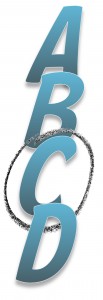
Reliability: Reliability is defined as the degree to which a test consistently measures a learning outcome. Multiple choice test items are less susceptible to guessing than true/false questions, making them a more reliable means of assessment. The reliability is enhanced when the number of MC items focused on a single learning objective is increased. In addition, the objective scoring associated with multiple choice test items frees them from problems with scorer inconsistency that can plague scoring of essay questions.
Validity: Validity is the degree to which a test measures the learning outcomes it purports to measure. Because students can typically answer a multiple choice item much more quickly than an essay question, tests based on multiple choice items can typically focus on a relatively broad representation of course material, thus increasing the validity of the assessment.
The key to taking advantage of these strengths, however, is construction of good multiple choice items.
A multiple choice item consists of a problem, known as the stem, and a list of suggested solutions, known as alternatives. The alternatives consist of one correct or best alternative, which is the answer, and incorrect or inferior alternatives, known as distractors.
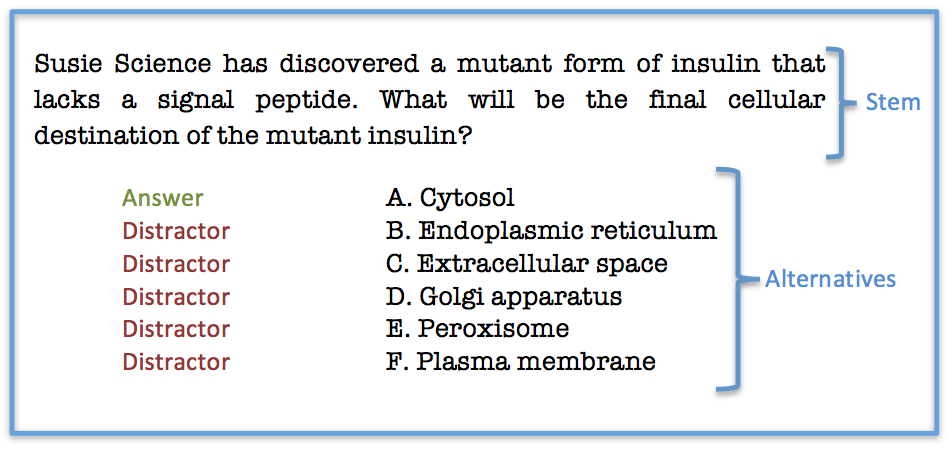
1. The stem should be meaningful by itself and should present a definite problem. A stem that presents a definite problem allows a focus on the learning outcome. A stem that does not present a clear problem, however, may test students’ ability to draw inferences from vague descriptions rather serving as a more direct test of students’ achievement of the learning outcome.
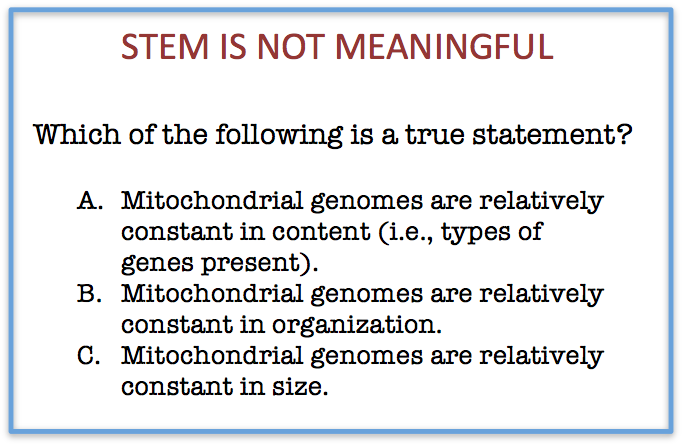
2. The stem should not contain irrelevant material , which can decrease the reliability and the validity of the test scores (Haldyna and Downing 1989).
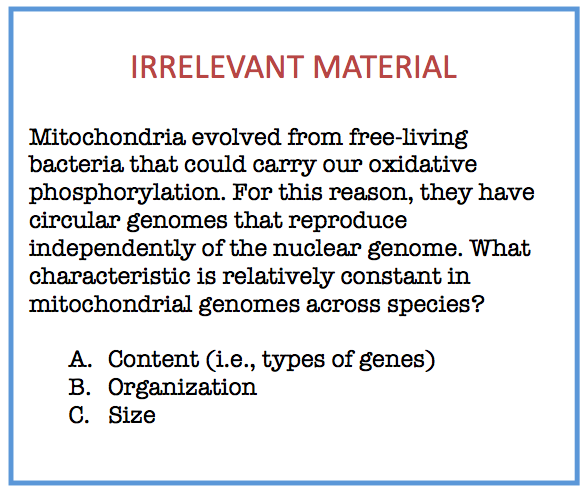
3. The stem should be negatively stated only when significant learning outcomes require it. Students often have difficulty understanding items with negative phrasing (Rodriguez 1997). If a significant learning outcome requires negative phrasing, such as identification of dangerous laboratory or clinical practices, the negative element should be emphasized with italics or capitalization.

4. The stem should be a question or a partial sentence. A question stem is preferable because it allows the student to focus on answering the question rather than holding the partial sentence in working memory and sequentially completing it with each alternative (Statman 1988). The cognitive load is increased when the stem is constructed with an initial or interior blank, so this construction should be avoided.
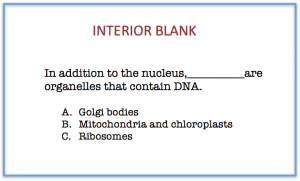
1. All alternatives should be plausible. The function of the incorrect alternatives is to serve as distractors,which should be selected by students who did not achieve the learning outcome but ignored by students who did achieve the learning outcome. Alternatives that are implausible don’t serve as functional distractors and thus should not be used. Common student errors provide the best source of distractors.

2. Alternatives should be stated clearly and concisely. Items that are excessively wordy assess students’ reading ability rather than their attainment of the learning objective
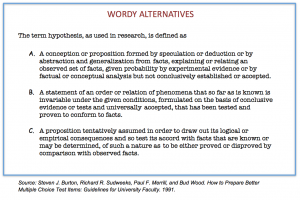
3. Alternatives should be mutually exclusive. Alternatives with overlapping content may be considered “trick” items by test-takers, excessive use of which can erode trust and respect for the testing process.
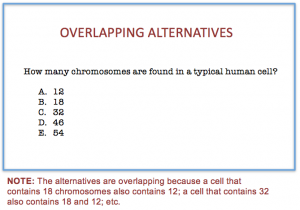
4. Alternatives should be homogenous in content. Alternatives that are heterogeneous in content can provide cues to student about the correct answer.
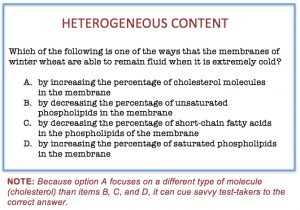
5. Alternatives should be free from clues about which response is correct. Sophisticated test-takers are alert to inadvertent clues to the correct answer, such differences in grammar, length, formatting, and language choice in the alternatives. It’s therefore important that alternatives
- have grammar consistent with the stem.
- are parallel in form.
- are similar in length.
- use similar language (e.g., all unlike textbook language or all like textbook language).
6. The alternatives “all of the above” and “none of the above” should not be used. When “all of the above” is used as an answer, test-takers who can identify more than one alternative as correct can select the correct answer even if unsure about other alternative(s). When “none of the above” is used as an alternative, test-takers who can eliminate a single option can thereby eliminate a second option. In either case, students can use partial knowledge to arrive at a correct answer.
7. The alternatives should be presented in a logical order (e.g., alphabetical or numerical) to avoid a bias toward certain positions.
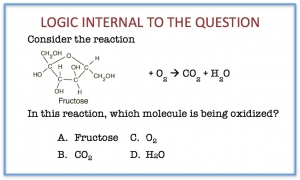
8. The number of alternatives can vary among items as long as all alternatives are plausible. Plausible alternatives serve as functional distractors, which are those chosen by students that have not achieved the objective but ignored by students that have achieved the objective. There is little difference in difficulty, discrimination, and test score reliability among items containing two, three, and four distractors.
Additional Guidelines
1. Avoid complex multiple choice items , in which some or all of the alternatives consist of different combinations of options. As with “all of the above” answers, a sophisticated test-taker can use partial knowledge to achieve a correct answer.
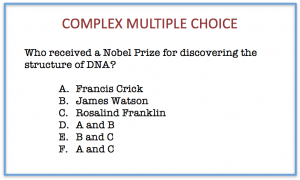
2. Keep the specific content of items independent of one another. Savvy test-takers can use information in one question to answer another question, reducing the validity of the test.
When writing multiple choice items to test higher-order thinking, design questions that focus on higher levels of cognition as defined by Bloom’s taxonomy . A stem that presents a problem that requires application of course principles, analysis of a problem, or evaluation of alternatives is focused on higher-order thinking and thus tests students’ ability to do such thinking. In constructing multiple choice items to test higher order thinking, it can also be helpful to design problems that require multilogical thinking, where multilogical thinking is defined as “thinking that requires knowledge of more than one fact to logically and systematically apply concepts to a …problem” (Morrison and Free, 2001, page 20). Finally, designing alternatives that require a high level of discrimination can also contribute to multiple choice items that test higher-order thinking.

- Burton, Steven J., Sudweeks, Richard R., Merrill, Paul F., and Wood, Bud. How to Prepare Better Multiple Choice Test Items: Guidelines for University Faculty, 1991.
- Cheung, Derek and Bucat, Robert. How can we construct good multiple-choice items? Presented at the Science and Technology Education Conference, Hong Kong, June 20-21, 2002.
- Haladyna, Thomas M. Developing and validating multiple-choice test items, 2 nd edition. Lawrence Erlbaum Associates, 1999.
- Haladyna, Thomas M. and Downing, S. M.. Validity of a taxonomy of multiple-choice item-writing rules. Applied Measurement in Education , 2(1), 51-78, 1989.
- Morrison, Susan and Free, Kathleen. Writing multiple-choice test items that promote and measure critical thinking. Journal of Nursing Education 40: 17-24, 2001.

Teaching Guides
- Online Course Development Resources
- Principles & Frameworks
- Pedagogies & Strategies
- Reflecting & Assessing
- Challenges & Opportunities
- Populations & Contexts
Quick Links
- Services for Departments and Schools
- Examples of Online Instructional Modules
- Literary Terms
- Definition & Examples
- When & How to Write an Essay
1. An essay is
a. a song with a story
b. a poem that has many stanzas
c. a type of writing that has organized paragraphs
d. a type of writing that requires research
2. The introductory paragraph of an essay requires
a. The topic, thesis, and main ideas
b. The topic, thesis, and supporting details
c. The reason for the essay, the topic, and thesis
3. Essays are
a. Easier to write because you can put your opinion
b. Harder to write because they require a lot of research
c. Flexible because you can use a narrative style or structured paragraphs
4. When writing the main idea paragraphs
a. Include the thesis to remind the reader
b. Include supporting details with examples and specific details
c. Make sure the supporting details are clearly shown through the main idea
d. Use opinion to show why your thesis is right
5. The conclusion of an essay should
a. Include last minute ideas and thoughts for the future
b. Have a restatement of the thesis and thoughts for the future
c. Be a recap of the whole essay
d. Be only two sentences
List of Terms
- Alliteration
- Amplification
- Anachronism
- Anthropomorphism
- Antonomasia
- APA Citation
- Aposiopesis
- Autobiography
- Bildungsroman
- Characterization
- Circumlocution
- Cliffhanger
- Comic Relief
- Connotation
- Deus ex machina
- Deuteragonist
- Doppelganger
- Double Entendre
- Dramatic irony
- Equivocation
- Extended Metaphor
- Figures of Speech
- Flash-forward
- Foreshadowing
- Intertextuality
- Juxtaposition
- Literary Device
- Malapropism
- Onomatopoeia
- Parallelism
- Pathetic Fallacy
- Personification
- Point of View
- Polysyndeton
- Protagonist
- Red Herring
- Rhetorical Device
- Rhetorical Question
- Science Fiction
- Self-Fulfilling Prophecy
- Synesthesia
- Turning Point
- Understatement
- Urban Legend
- Verisimilitude
- Essay Guide
- Cite This Website

- school Campus Bookshelves
- menu_book Bookshelves
- perm_media Learning Objects
- login Login
- how_to_reg Request Instructor Account
- hub Instructor Commons
- Download Page (PDF)
- Download Full Book (PDF)
- Periodic Table
- Physics Constants
- Scientific Calculator
- Reference & Cite
- Tools expand_more
- Readability
selected template will load here
This action is not available.

4: Types of Essays
- Last updated
- Save as PDF
- Page ID 165699

- Ann Inoshita, Karyl Garland, Kate Sims, Jeanne K. Tsutsui Keuma, and Tasha Williams
- University of Hawaii via University of Hawaiʻi OER
Learning Objectives
Student will be able to do the following after reading this chapter:
- Apply essay structure to various rhetorical modes.
- Provide the required components of a specific essay assignment.
- 4.1: Introduction Rhetorical modes are simply the ways in which people effectively communicate through language. Sometimes writers incorporate a variety of modes in any one essay. For example, a persuasive essay may include paragraphs showing cause and effect, description, and narrative. The rhetorical mode writers choose depends on the purpose for writing. Rhetorical modes are a set of tools that will allow students greater flexibility and effectiveness in communicating with their audience and expressing ideas.
- 4.2.1: Memoir or Personal Narrative- Learning Lessons from the Personal
- 4.2.1.1: Exploring the Past to Understand the Present
- 4.2.1.2: Trailblazer
- 4.2.1.3: Glance at Genre- Conflict, Detail, and Revelation
- 4.3: Process Analysis A process analysis essay explains how to do something or how something works. In either case, the formula for a process analysis essay remains the same. The process is articulated into clear, definitive steps. Almost everything writers do involves following a step-by-step process. From riding a bike as children to learning various jobs as adults, writers initially needed instructions to effectively execute the task.
- 4.4: Evaluation This section discusses the purpose and structure of evaluation, as many students prepare to write their own evaluative essays.
- 4.5: Comparison and Contrast
- 4.6.1: Persuasion/Argument
Thumbnail: Photo by Helloquence on Unsplash

What are MCQs? A Comprehensive Guide to 24 Types with Examples
Welcome to our comprehensive guide on Multiple Choice Questions (MCQs). MCQs are the most commonly used assessment format worldwide. They are a regular part of educational and professional settings, offering a versatile way to evaluate and test your knowledge.
If you’re a student getting ready for tests , an educator seeking effective assessment methods, or simply curious about the inner workings of MCQs, this guide is designed to be your go-to resource. By the end of this article, you’ll have a comprehensive understanding of MCQs, enabling you to approach them with confidence and decode their underlying mechanics. Let’s start learning about MCQs!
Additionally, to enhance your exam preparation, explore MCQs for Exams – a valuable resource providing subject-wise and topic-wise sample MCQs. These practice questions are designed to improve your understanding of multiple-choice questions and boost your exam readiness effectively.
What are MCQs?
MCQ or MCQs is a commonly used abbreviation for “Multiple Choice Questions” around the world. Multiple Choice Questions (MCQs) are a form of test or quiz question that offers multiple choices, typically including one accurate answer and various incorrect ones. Your task is to select the correct response from the given options. MCQs serve as a way to evaluate your knowledge, grasp of concepts, and ability to make informed decisions across various subjects and areas. Widely employed in education, assessments , and evaluations, they provide a means to gauge your familiarity with a subject matter. MCQs are commonly used in aptitude tests , IQ assessments , and personality evaluations .
Additionally, Multiple Choice Questions (MCQs) play a crucial role in surveys and questionnaires, offering an organized method to gather insights and opinions from respondents. Whether in market research, social studies, or scientific investigations, MCQs simplify data collection by providing predefined response options. This standardized approach streamlines analysis and ensures reliable data, facilitating informed decision-making across diverse fields.
History of Multiple-Choice Questions
The history of Multiple-Choice Questions (MCQs) dates back to 1914 when educational psychologist Frederick J. Kelly introduced the concept. He designed them as a practical way to score exams more efficiently. Over time, MCQs gained popularity due to their ability to assess a broad range of content and provide objective grading. Today, they are a widely used assessment format in education, professional settings, and various online platforms.
Components of Multiple-Choice Questions
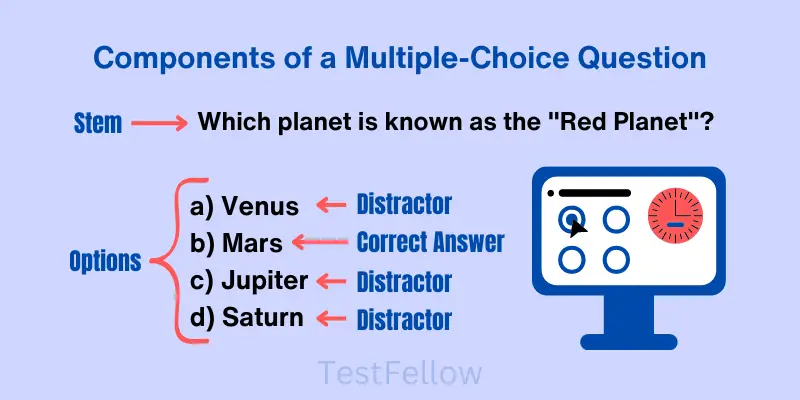
Multiple-choice questions (MCQs) consist of a stem, options or choices, correct answer(s), and distractors. Breaking down an MCQ into its individual parts can help you approach these questions more effectively.
1. Question Stem:
This is the main part of the MCQ that presents the problem or question you need to answer. It provides context and sets the stage for the choices that follow.
2. Options or Choices:
MCQs offer a set of options from which you must choose the correct answer. These choices are carefully crafted to challenge your knowledge and comprehension.
3. Correct Answer:
Among the options, one is the correct answer. Your task is to identify this accurate choice based on your understanding of the question.
4. Incorrect Answers (Distractors):
Distractors in multiple-choice questions are cleverly crafted incorrect answers meant to challenge your thinking. They’re designed to encourage careful consideration and smart choices. Even though distractors might seem correct, they’re actually wrong. They’re used to test how well you truly grasp the subject and can separate truth from falsehood. Their main role is to see if you can tell what’s real and what’s not.
Understanding these different components will enhance your ability to tackle MCQs effectively and boost your success in assessments and exams.
Types of MCQs with Examples
Multiple-choice questions (MCQs) come in various types, each serving a distinct purpose in assessing your knowledge and understanding. Let’s explore these 24 types along with illustrative examples to help you grasp their formats and applications. If you’re looking for guidance on how to answer multiple-choice questions , we’ve got you covered!”
1. Single-Answer MCQs
Single-Answer MCQs pose a question alongside several options, with just one being correct. These questions assess your capacity to discern the precise answer from the provided choices. Such MCQs focus on evaluating your ability to make accurate selections, compelling you to navigate through potential distractors and choose the most fitting response. They are a fundamental tool in testing your knowledge, comprehension, and analytical skills across various subjects and assessments. Mastering single-answer MCQs involves not only understanding the content but also honing your ability to make informed decisions within a limited context.
Example Question:
Which planet is known as the “Red Planet”? a) Venus b) Mars (Correct Answer) c) Jupiter d) Saturn
2. Multiple-Answer MCQs
Multiple-Answer MCQs introduce a different challenge by presenting a question along with options, where more than one answer can be correct. These questions gauge your ability to identify all accurate choices within a specific context. They require a deeper understanding of the subject matter, as you must discern multiple correct responses while also differentiating them from distractors. Excelling in multiple-answer MCQs demonstrates your grasp of nuanced concepts and your skill in differentiating between valid and incorrect choices. This type of MCQ adds complexity to assessments, testing not only your knowledge but also your precision in selecting multiple correct solutions to reflect a comprehensive understanding.
Which of the following are primary colors? a) Red (Correct Answer) b) Yellow c) Green (Correct Answer) d) Purple e) Blue (Correct Answer) f) Black
3. True/False MCQs
True/False MCQs center on statements that you classify as either true or false. These questions serve as a tool to evaluate your grasp of particular facts or concepts. With a binary nature, True/False MCQs prompt you to analyze the accuracy of provided statements, reinforcing your comprehension of fundamental information. While seemingly straightforward, these MCQs demand careful consideration, as they test your ability to differentiate between accurate and incorrect statements.
Excelling in True/False MCQs requires not only factual knowledge but also the ability to critically evaluate information, making them an essential component of assessments that assess both rote understanding and critical thinking skills.
Is the following statement true or false? Water boils at 100°C. a) True (Correct Answer) b) False
4. Yes/No MCQs
A Yes or No MCQ is a simple format where a statement or question is presented, and respondents have the choice of answering either “Yes” or “No”. This type of question is easy to understand and quick to answer, making it suitable for gathering straightforward opinions or facts. This format is often used to obtain quick and clear responses from participants.
Is the Earth round? a) Yes (Correct Answer) b) No
5. Odd One Out MCQs
The Odd One Out Multiple Choice Question (MCQ) challenges respondents to identify an item that doesn’t fit with the rest in a given group. By presenting a collection of items, this format evaluates the participant’s capacity to detect variations and patterns among them. This type of question encourages critical thinking and observation skills as respondents analyze the items to pinpoint the one that deviates from the expected pattern or category. It’s a creative way to assess cognitive abilities related to identifying distinctions within a set of options.
Example Question:
Which of these is the odd one out? a) Apple b) Banana c) Orange d) Carrot (Correct Answer)
6. Best Answer MCQ
In a “best answer MCQ”, respondents are presented with a list of choices and are tasked with selecting the option that best fits the provided context or is most accurate. This format aims to evaluate a participant’s ability to critically analyze the options and discern the most suitable response based on the given information. It encourages respondents to apply their understanding and judgment to identify the option that aligns most effectively with the question’s requirements.
Choose the best answer: Which study method is most effective? a) Studying briefly before a test b) Regularly Studying (Best Answer) c) Studying only important questions d) Cramming all night before an exam
7. Matching Type MCQs
Matching Type MCQs present a unique challenge where you’re tasked with creating meaningful pairs by linking items from two separate columns. This type of question assesses your aptitude for establishing logical relationships and connections between distinct elements. By requiring you to identify correlations and linkages, matching MCQs evaluate your ability to discern patterns, draw associations, and comprehend the interplay between different pieces of information.
Excelling in this category showcases your proficiency in recognizing relationships, making it a valuable skill in subjects that demand analytical thinking and the ability to synthesize information cohesively.
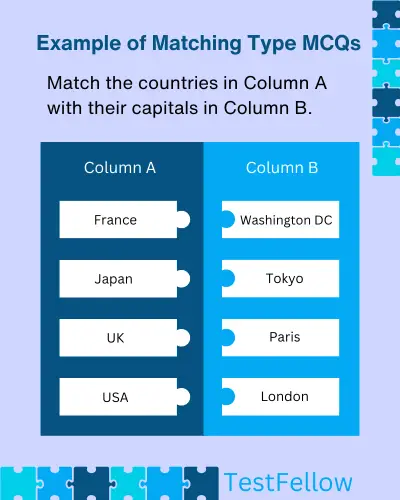
8. Drag and Drop MCQ
Drag and Drop Multiple Choice Questions (MCQs) add an engaging twist to traditional assessments. In this format, you’re provided with a set of options that you can literally move around the screen—dragging and dropping them into their appropriate positions. This dynamic interaction challenges you to match choices accurately to their respective contexts, effectively evaluating your ability to establish connections and make informed selections.
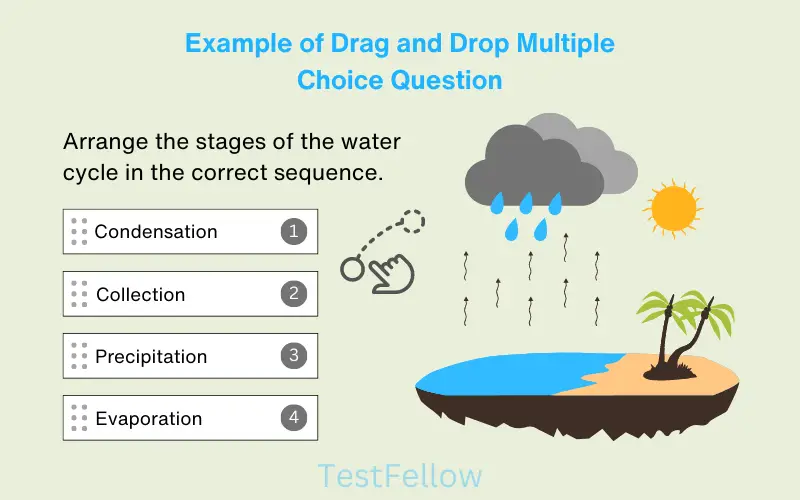
9. Drop Down Menu MCQs
Drop-down Menu MCQs present a question with answer options that appear in a dropdown list. In this format, you select the correct answer from the available choices, utilizing a concise and organized display for multiple options. This user-friendly format simplifies the presentation of choices, eliminating clutter and ensuring a seamless interaction.
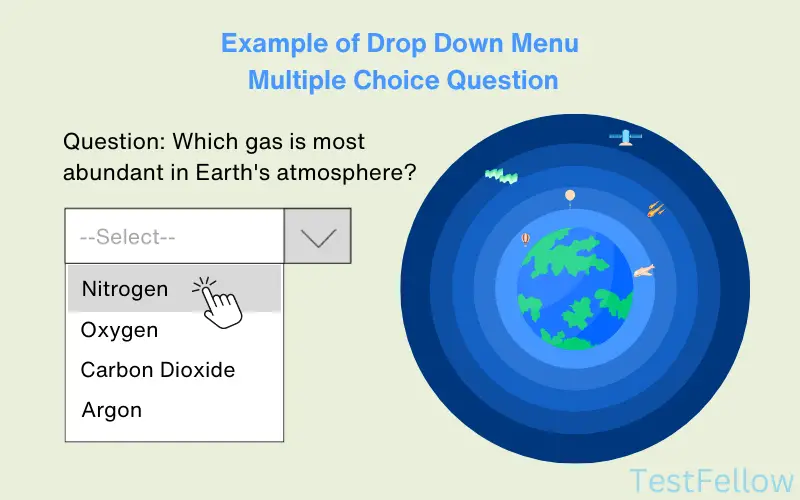
10. Star Rating MCQs
Star Rating Multiple Choice Questions (MCQs) employ a familiar rating system, often depicted as stars, to gauge your evaluation of different options. This format proves valuable for assessing preferences or qualities on a graduated scale. By assigning stars to each choice, you express your judgment of factors like importance, difficulty, or satisfaction, providing a nuanced way to quantify subjective attributes.
Star Rating MCQs are particularly effective when a quantitative measure is required, allowing learners to communicate their opinions with precision and enabling educators to gather insights into nuanced preferences or perceptions.
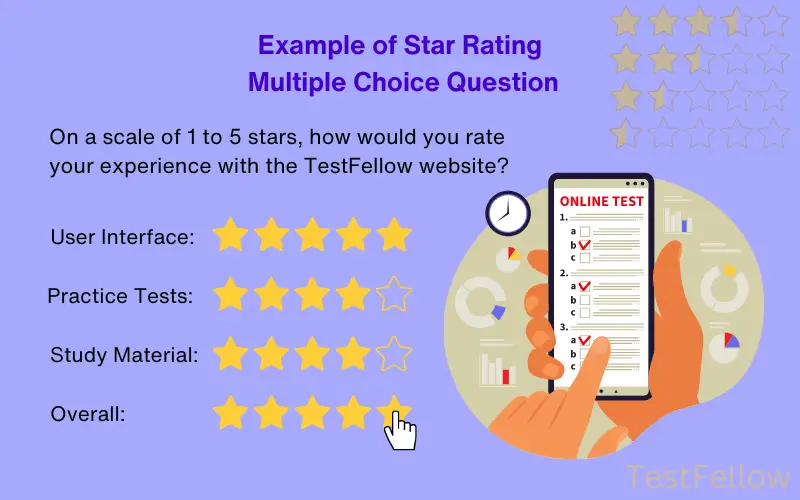
11. Text Slider MCQ
An excellent substitute for open-ended questions, Text Slider MCQs offer an interactive twist. They present a scale with text-based choices, allowing you to slide the marker and share preferences, opinions, or evaluations within a defined range. This dynamic method empowers users to provide detailed responses that match their viewpoints with precision. Text Slider MCQs enhance evaluation by providing versatile feedback options, enabling users to precisely convey their thoughts while maintaining a user-friendly experience.
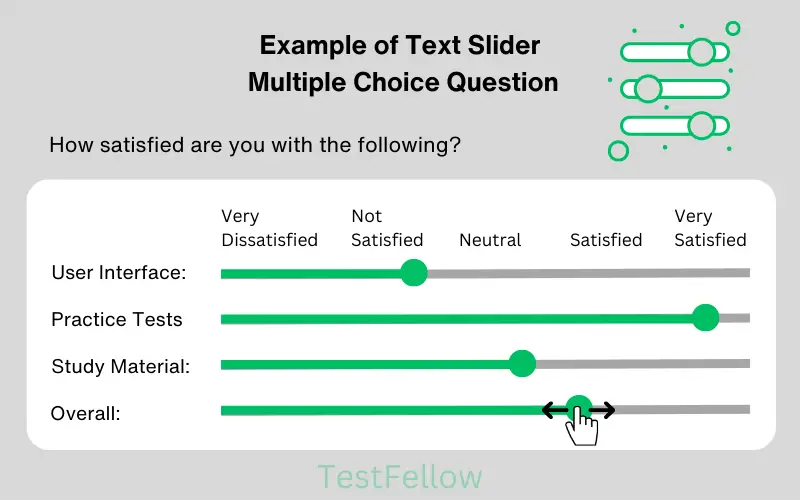

12. Numeric Slider MCQs
Numeric Slider MCQs offer an interactive twist, featuring a sliding scale with numeric choices. Users adjust the slider to select a numerical value that aligns with the context provided. This dynamic format empowers participants to quantitatively express their preferences, estimates, or judgments.
This type of MCQs enrich assessment by enabling precise quantification within a user-friendly interface, promoting engagement, and enhancing the depth of responses across various numerical contexts.
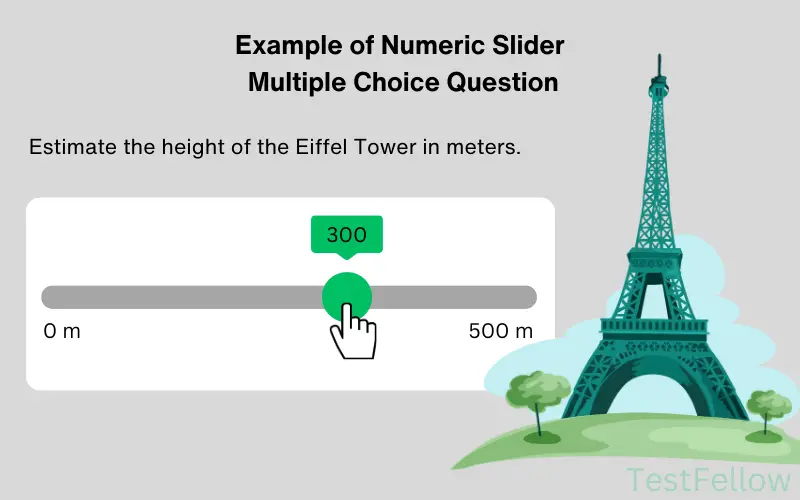
13. Push to Social Media MCQs
Push to Social MCQs add an interactive dimension by prompting users to share their responses on social media. This innovative approach sparks engagement and conversations related to the question’s theme, cultivating a collaborative learning space.
For instance, when asked about historical figures, users can push their choice to Twitter and invite friends to participate. This format not only enhances individual learning but also extends the educational experience to online communities, promoting insightful discussions and diverse perspectives through interactive sharing.
14. Thumbs Up/Down MCQs
Thumbs Up/Down MCQs offer a simple binary choice using thumbs-up and thumbs-down icons. You indicate your agreement or disagreement with a statement. The choices essentially comprise an icon or image representing thumbs up or thumbs down, which assists in describing the rating choice. It helps people quickly decide if they like or don’t like something.
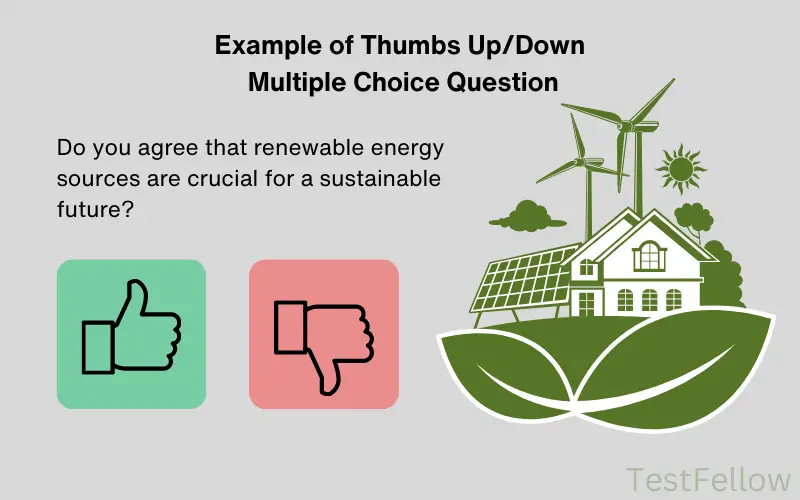
15. Smiley Rating MCQ
Smiley Rating MCQs infuse assessments with emotive expressions, employing smiley faces to convey varying degrees of sentiment or preference. Respondents select the smiley that resonates with their viewpoint, enriching responses with emotional context.
This format not only quantifies opinions but also integrates feelings into learning. Smiley Rating MCQs foster engagement by offering an intuitive, visually appealing interface that enables participants to communicate sentiments effectively and contribute depth to their feedback.
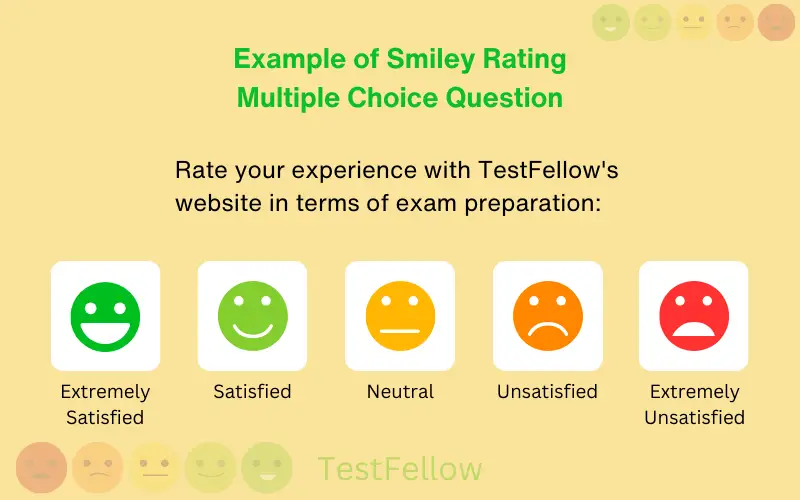
16. Matrix Table Multiple Choice Question
In this type, respondents are presented with a table consisting of rows and columns. Each row represents a specific item or statement, while each column represents different options or levels of agreement, importance, etc. Respondents are required to choose one option from each row. This format is useful for assessing multiple variables or preferences simultaneously.
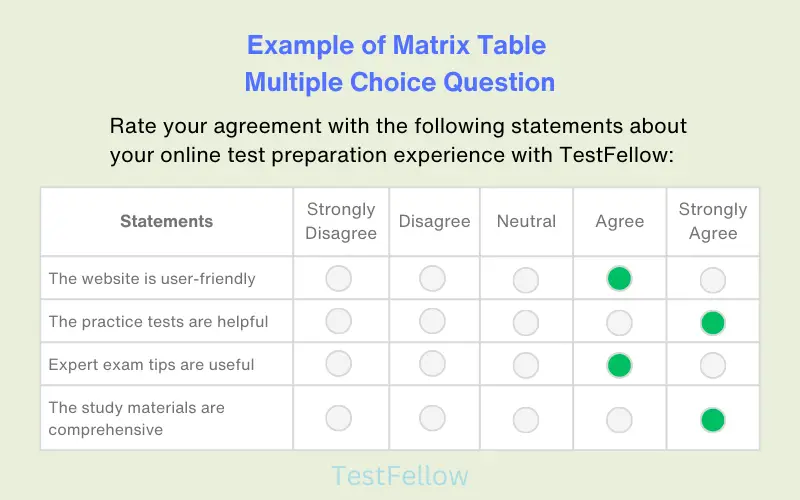
17. Multi Point Scale Matrix Table MCQs
This type is similar to the Matrix Table MCQs, but it allows respondents to select multiple options from each row instead of just one. This allows for a more nuanced response, as respondents can indicate varying levels of agreement or preference for each item.
18. Spreadsheet-based MCQs
Spreadsheet-based MCQs employ a spreadsheet-like interface, enabling participants to interact with cells housing text box options. This setup is apt for situations demanding calculations, comparisons, or data manipulations. These types of questions enable respondents to input text explaining their chosen answer. Typically, these choices span the spectrum from ‘extremely like’ to ‘extremely dislike,’ accompanied by reasons for their preference and possible suggestions.
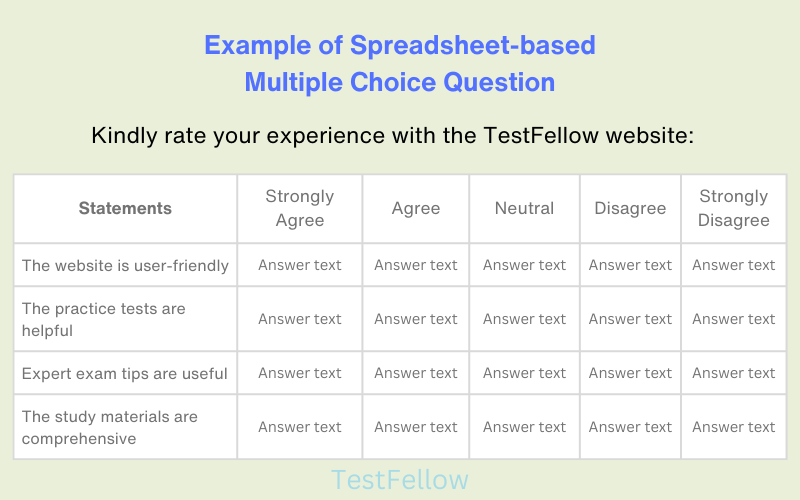
19. Side-By-Side Matrix Table MCQ
The Side-by-Side Matrix Table Multiple Choice Question is a powerful tool for condensing multiple questions into a single table. Within this format, every column becomes an independent question, complete with its structure, format, and options. Each row corresponds to an item, and respondents address these side-by-side inquiries accordingly. This approach streamlines the assessment process, making it efficient and informative.
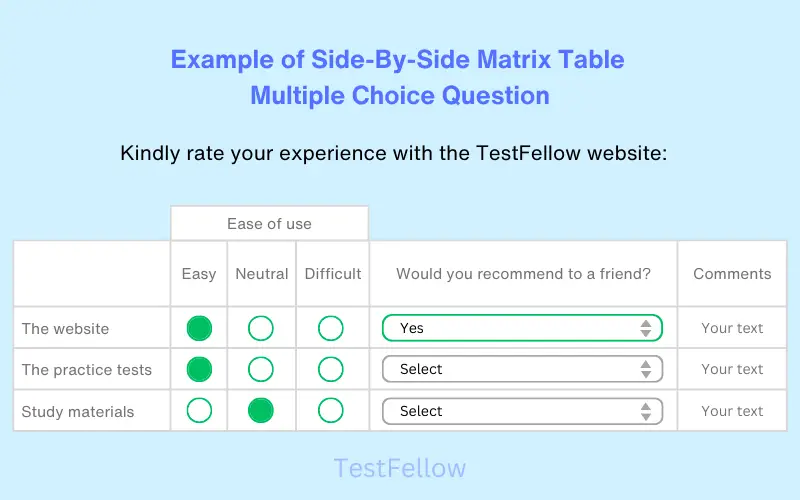
20. Rank Order Multiple Choice Question
The Rank Order question type offers respondents a distinctive chance to arrange a group of items in order of preference. For instance, in rank order scaling-based multiple-choice questions, a selection of brands or products can be ranked according to a specific quality. This ranking can be represented numerically using a dropdown box. When included in a survey, this question helps the creator grasp the respondent’s sequence of preference, offering insights into their choice priority.
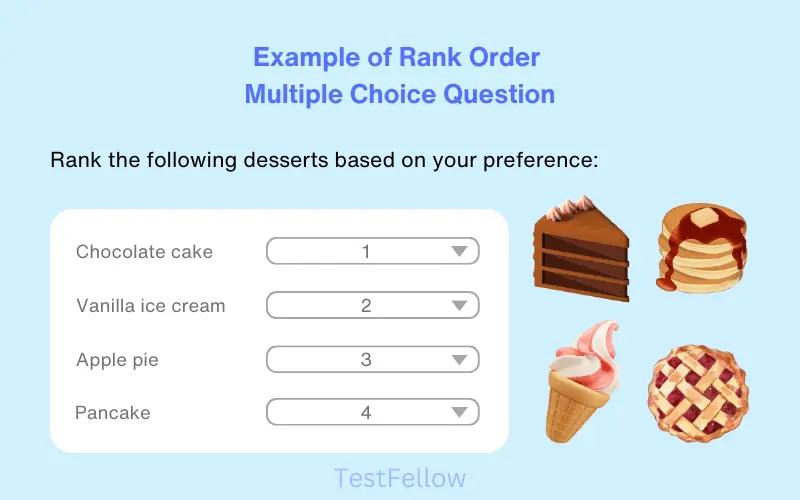
21. Constant Sum Multiple Choice Question
The Constant Sum multiple choice question structure assigns participants a specific sum of points for distribution among several choices, gauging their significance or relevance. This approach illuminates the hierarchy of priorities in a comparative manner. This question type empowers respondents to input numerical values across multiple variables, ensuring the total adds up to a predetermined sum. The cumulative value of these numeric entries can be showcased to the respondents. This type of question proves highly effective for inquiries concerning financial matters, budgeting, and percentage-based scenarios.

22. Single-Answer Image-Based MCQs:
Single Answer Image-Based MCQs combine the visual aspect with the traditional multiple-choice format. Here, radio buttons are utilized to facilitate your selection of the correct answer based on the visual provided. In these questions, an image or diagram is presented alongside options, where you must select the one correct answer based on the visual content provided.
This type of MCQ evaluates your ability to interpret visual information and apply it to the question’s context. By analyzing images, charts, or diagrams, you demonstrate your capacity to connect visual cues with the subject matter, fostering a holistic understanding. Excelling in these MCQs showcases your aptitude for visual learning and critical thinking, proving valuable in fields that require visual analysis and comprehension.
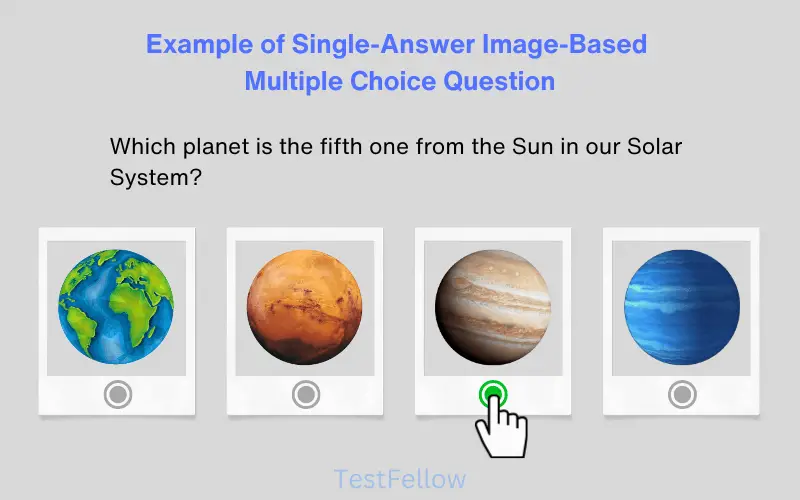
23. Multiple Answer Image-Based MCQs
Multiple Answer Image-Based MCQs operate much like Single Answer Image-Based MCQs, but the key difference is that you’re allowed to select more than one image option. In this format, an image or diagram accompanies response options, creating an engaging learning experience. Notably, checkboxes are employed to enable you to choose multiple correct answers based on the visual content provided. These MCQs assess your ability to interpret visual information, recognize patterns, and apply them to the context of the question.
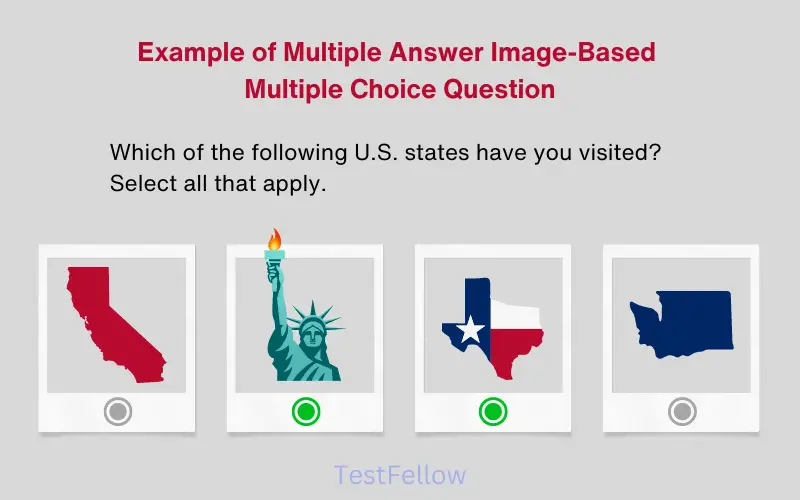
24. Image Rating MCQs
An image rating question falls under the umbrella of close-ended questions. It presents respondents with a range of image-based options, from which they select single or multiple images that resonate the most with them. Similar to other multiple-choice questions, the distinction here lies in the format—options are visual representations. The primary aim of image rating questions is to captivate respondents and provide a deeper comprehension of each option’s essence. These questions, presented in visual form, serve to actively involve participants and offer a more vivid understanding of the choices at hand.
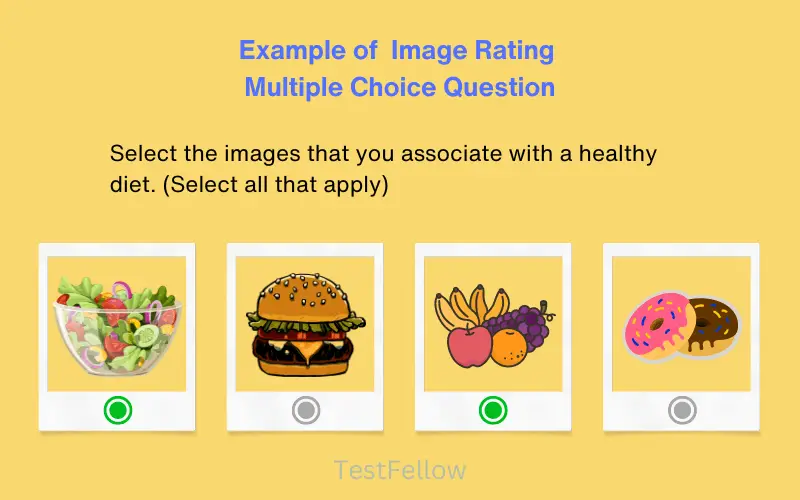
Each of these creative MCQ formats adds an interactive and engaging element to the assessment process, catering to various learning preferences and enhancing your understanding of the subject matter.
Advantages of Multiple Choice Questions
Multiple Choice Questions (MCQs) are widely used in the educational sector and workplaces due to their numerous benefits. These question formats offer a range of advantages that contribute to their widespread use and popularity. In this section, we’ll explore five of the most significant benefits that MCQs bring to the table.
1. Efficient Assessment
MCQs enable efficient evaluation of a wide range of content within a relatively short time. Educators and examiners can cover a diverse array of topics and concepts in a single assessment, allowing for comprehensive testing of knowledge.
2. Objective Evaluation
The objective nature of MCQs reduces subjectivity in grading. Since there’s a clear right answer for each question, grading is consistent and eliminates potential bias or interpretation discrepancies.
3. Quick Feedback
MCQ assessments offer swift feedback to both learners and educators. With automated grading systems, learners can promptly identify areas of strength and weakness, while educators can adjust their teaching strategies accordingly.
4. Assessing Diverse Cognitive Levels
MCQs can be crafted to assess various cognitive levels, from basic recall of facts to higher-order thinking skills like analysis and application. This versatility allows educators to gauge a broad spectrum of learning outcomes.
5. Higher Response Rates and Increased Participation
One of the significant advantages of employing Multiple Choice Questions (MCQs) is the potential for higher response rates and increased participation. Due to their structured and concise format, MCQs are often perceived as less time-consuming as compared to open ended questions, encouraging a larger number of individuals to engage with the assessment or survey. This uptick in participation is particularly beneficial in educational settings, where teachers can gauge student understanding effectively.
Moreover, in business contexts, the higher response rates translate to more comprehensive insights from customers or stakeholders, enabling organizations to make well-informed decisions based on a broader range of perspectives.
Incorporating MCQs into assessments and educational materials offers a range of advantages that streamline the learning process and promote effective evaluation.
Disadvantages of Multiple Choice Questions
The advantages associated with Multiple Choice Questions (MCQs) are undeniably significant. However, it is equally crucial to recognize the limitations that accompany their application. In this section, we’ll explore MCQs’ disadvantages, highlighting areas where they might not fully serve as effective assessment tools.
1. Limited Depth of Understanding
While MCQs are useful for assessing factual knowledge, they might not effectively capture the depth of a student’s understanding. These questions often present options that require recall rather than analysis. In subjects where complex concepts and critical thinking are crucial, MCQs may fall short in evaluating a student’s ability to grasp intricate connections and apply knowledge in practical scenarios.
2. Guessing and Chance
MCQs, especially those with multiple choices, can accidentally reward lucky guesses. Respondents might select an option based on partial knowledge or eliminate obviously incorrect choices, potentially leading to inflated scores that do not truly reflect their expertise. This element of chance could undermine the accuracy of the assessment and blur the distinction between knowledgeable respondents and those who merely guessed right.
3. Narrow Assessment Scope
Due to the limited format of MCQs, they might not cover the full spectrum of a topic. This could result in overlooking crucial nuances and aspects of understanding. For subjects requiring a holistic comprehension or interdisciplinary connections, MCQs might inadvertently prioritize certain aspects while neglecting others, thus providing an incomplete picture of a student’s overall knowledge.
4. Avoiding Critical Thinking
MCQs, often designed to have clear-cut answers, might encourage memorization of facts rather than the application of critical thinking skills. Students might focus on memorizing options rather than engaging in analytical reasoning or problem-solving. In the real world, where ambiguity and complex situations are common, the absence of critical thinking assessment could hinder a student’s ability to tackle unfamiliar challenges effectively.
With this expansive exploration of 24 diverse MCQ types complemented by illustrative examples and insights into their advantages and disadvantages, you have delved deep into the world of multiple-choice questions. Armed with this comprehensive insight, you’re empowered to navigate the intricacies of MCQs with confidence, applying your newfound knowledge to assessments, evaluations, and learning scenarios. Your enriched understanding of this versatile format equips you to approach various subjects and situations with a heightened sense of comprehension and adeptness. Whether you’re preparing for exams, job tests, or online assessments, you can now navigate them with assured confidence.
FAQs about Multiple Choice Questions
1. who invented the mcqs.
The invention of MCQs is attributed to Frederick J. Kelly, an American educational psychologist. He introduced the concept in 1914 as a way to efficiently score large numbers of exams. The format gained popularity due to its effectiveness in assessing a wide range of content and providing objective grading.
2. What does MCQ stand for?
MCQ or MCQs stands for Multiple Choice Question. It’s an abbreviation commonly used to refer to a type of objective assessment where respondents choose the most appropriate answer from a list of options. This format is also known as multiple choice (MC) or objective response.
3. What is the purpose of MCQs test?
The purpose of Multiple Choice Questions (MCQs) tests is to assess a person’s understanding and knowledge of a particular subject or topic. MCQs present a question along with several answer choices, among which one or more are correct. MCQs assess various cognitive skills, from basic recall to critical thinking. Their structured setup enables effective assessment across content areas, valuable for educators, employers, and learners for informed choices.
4. Can practical skills be assessed with MCQs?
Yes, practical skills can be evaluated through scenario-based MCQs. These questions present real-life situations, allowing test-takers to apply their knowledge to practical scenarios. For example, a nursing exam might include a scenario where students choose the most appropriate response for a patient’s specific condition, assessing their ability to apply medical knowledge in a realistic context.
5. How do MCQs aid learning?
MCQs aid learning by encouraging active recall and engagement. When answering MCQs, learners retrieve information from memory, reinforcing their understanding of the material. Additionally, MCQs prompt critical thinking as they require analyzing options to identify the correct answer. This interactive approach promotes deeper comprehension and retention of concepts.
6. Why are there different types of multiple-choice questions?
The existence of different types of multiple-choice questions serves to cater to various learning styles, subject matters, and assessment objectives. Each type emphasizes different skills and cognitive abilities. For instance, image-based MCQs evaluate visual interpretation skills, while text slider MCQs assess nuanced preferences. Having different types helps teachers and testers understand many aspects of how well someone understands, thinks, and uses what they’ve learned, which makes tests better suited to each person.
Related Articles:
- What Are Assessments? 14 Types with Examples
- A Comprehensive Guide to 23 Types of Questions
- What Is a Psychometric Test – A Comprehensive Guide
- What is an IQ Test – A Comprehensive Guide
- What are Personality Tests – A Comprehensive Guide
- What are Aptitude Tests – A Comprehensive Guide
- What is a Test? 10 Types of Tests in Education
- Top 10 Tips to Prepare for a Psychometric Test
- How to Pass an Aptitude Test: Top 10 Effective Tips
- How to Prepare for Personality Tests: 10 Expert Tips
- How to Answer Multiple Choice Questions: 10 Tips
- Create A Quiz
- Relationship
- Personality
- Harry Potter
- Online Exam
- Entertainment
- Training Maker
- Survey Maker
- Brain Games
- ProProfs.com
Argumentative Essay Quizzes, Questions & Answers
Top trending quizzes.
Popular Topics
Recent quizzes.
Have an account?
Suggestions for you See more

Paraphrasing Challenge
12th - university , the writing process, indefinite and definite articles, 8th - 11th , transitional words, kg - 2nd .

Essay Types
7th - 8th grade.
18 questions

Introducing new Paper mode
No student devices needed. Know more
- 1. Multiple Choice Edit 1.5 minutes 1 pt What is a narrative? A story Poetry A biography A research project
- 2. Multiple Choice Edit 1.5 minutes 1 pt _________________ means the time and place in which the events happen in a story. Chronological order Setting Dialogue Transition words
- 3. Multiple Choice Edit 1.5 minutes 1 pt Dialogue is Action at the end of the story The conversation between characters Authors point of view Chronological order
- 4. Multiple Choice Edit 20 seconds 1 pt What is the purpose of a narrative? To give the reader information To persuade readers To tell a story To describe characters
- 5. Multiple Choice Edit 20 seconds 1 pt A concluding statement is important because It gives information It conveys thoughts and ideas It provides closure to the end of the story It supports analysis and reflection
- 6. Multiple Choice Edit 1.5 minutes 1 pt An example of a sensory detail is Rattling thunder and lightening flashes Talking A magic wand Happy
- 7. Multiple Choice Edit 20 seconds 1 pt True or False. A narrative must have characters. True False
- 8. Multiple Choice Edit 20 seconds 1 pt Which part of the plot introduces the characters? Exposition Rising Action Climax Falling Action
What is the purpose of an explanatory essay?
To change your readers mind.
To tell an entertaining story.
To persuade or convince your readers.
To teach or explain information to your readers.
Where does the hook go and what does it do?
The first sentence of an introduction, grabs readers attention.
The first sentence of a body paragraph, gives evidence.
The last sentence of the essay, gives the claim.
Why do we need evidence in an essay?
To grab the readers attention.
To remind the readers our main point.
To entertain the reader.
To support and prove the claims of the body paragraphs. .
Where do you find evidence for your essay?
By reading the articles, and finding quotes that help prove your claim.
By giving your best guess.
By talking about your own personal experiences.
By asking the reader quesitons.
What is the purpose of an argumentative essay?
to explain the author's point of view
to claim a stance on an issue and convince the reader of that position
to persuade the reader to believe a position
to provide facts about a controversial issue
How is argumentative writing different from persuasive writing?
Persuasive writing and argumentative writing are actually the same.
Persuasive writing is more effective at convincing the reader than argumentative writing.
Persuasive writing is not the same as argumentative writing.
Persuasive writing uses emotional and feelings-based techniques to convince the reader of a position, while argumentative writing uses facts and statistics as evidence to convince the reader of a position.
Evidence for an argumentative essay can be
how the author feels about a topic
facts, statistics, or text evidence
the author's opinions
What is a counterclaim?
The opposite of a thesis statement.
This statement helps to support the claim.
The counterclaim is used to introduce the opposite view of the author's position or claim.
What is the purpose of an informative text ?
To entertain
To give information
To persuade
To give answers
This is an example of an informative text
Explore all questions with a free account

Continue with email
Continue with phone
Talk to our experts
1800-120-456-456
- Essay Writing

Introduction
In the simplest terms, an essay is a short piece of writing which is set around a specific topic or subject. The piece of writing will give information surrounding the topic but will also display the opinions and thoughts of the author. Oftentimes, an essay is used in an academic sense by way of examination to determine whether a student has understood their studies and as a way of testing their knowledge on a specific subject. An essay is also used in education as a way of encouraging a student to develop their writing skills.
Moreover; an essay is a focused piece of writing designed to inform or persuade. There are many different types of essays, but they are often defined in four categories: argumentative, expository, narrative, and descriptive essays. Argumentative and expository essays are focused on conveying information and making clear points, while narrative and descriptive essays are about exercising creativity and writing in an interesting way. At the university level, argumentative essays are the most common type.
Types of Essay Writing
When it comes to writing an essay, there is not simply one type, there are, quite a few types of essay, and each of them has its purpose and function which are as follows:
Narrative Essays
A narrative essay details a story, oftentimes from a particular point of view. When writing a narrative essay, you should include a set of characters, a location, a good plot, and a climax to the story. It is vital that when writing this type of essay you use fine details which will allow the reader to feel the emotion and use their senses but also give the story the chance to make a point.
Descriptive Essay
A descriptive essay will describe something in great detail. The subject can be anything from people and places to objects and events but the main point is to go into depth. You might describe the item’s color, where it came from, what it looks like, smells like, tastes like, or how it feels. It is very important to allow the reader to sense what you are writing about and allow them to feel some sort of emotion whilst reading. That being said, the information should be concise and easy to understand, the use of imagery is widely used in this style of essay.
Expository Essay
An expository essay is used as a way to look into a problem and therefore compare it and explore it. For the expository essay, there is a little bit of storytelling involved but this type of essay goes beyond that. The main idea is that it should explain an idea giving information and explanation. Your expository essay should be simple and easy to understand as well as give a variety of viewpoints on the subject that is being discussed. Often this type of essay is used as a way to detail a subject which is usually more difficult for people to understand, clearly and concisely.
Argumentative Essay
When writing an argumentative essay, you will be attempting to convince your reader about an opinion or point of view. The idea is to show the reader whether the topic is true or false along with giving your own opinion. You must use facts and data to back up any claims made within the essay.
Format of Essay Writing
Now there is no rigid format of an essay. It is a creative process so it should not be confined within boundaries. However, there is a basic structure that is generally followed while writing essays.
This is the first paragraph of your essay. This is where the writer introduces his topic for the very first time. You can give a very brief synopsis of your essay in the introductory paragraph. Generally, it is not very long, about 4-6 lines.
This is the main crux of your essays. The body is the meat of your essay sandwiched between the introduction and the conclusion. So the most vital content of the essay will be here. This need not be confined to one paragraph. It can extend to two or more paragraphs according to the content.
This is the last paragraph of the essay. Sometimes a conclusion will just mirror the introductory paragraph but make sure the words and syntax are different. A conclusion is also a great place, to sum up, a story or an argument. You can round up your essay by providing some morals or wrapping up a story. Make sure you complete your essays with the conclusion, leave no hanging threads.
Writing Tips
Give your essays an interesting and appropriate title. It will help draw the attention of the reader and pique their curiosity
Keep it between 300-500 words. This is the ideal length, you can take creative license to increase or decrease it
Keep your language simple and crisp. Unnecessary complicated and difficult words break the flow of the sentence.
Do not make grammar mistakes, use correct punctuation and spelling five-paragraph. If this is not done it will distract the reader from the content
Before beginning the essay, organize your thoughts and plot a rough draft. This way you can ensure the story will flow and not be an unorganized mess.
Understand the Topic Thoroughly-Sometimes we jump to a conclusion just by reading the topic once and later we realize that the topic was different than what we wrote about. Read the topic as many times as it takes for you to align your opinion and understanding about the topic.
Make Pointers-It is a daunting task to write an essay inflow as sometimes we tend to lose our way of explaining and get off-topic, missing important details. Thinking about all points you want to discuss and then writing them down somewhere helps in covering everything you hoped to convey in your essay.
Develop a Plan and Do The Math-Essays have word limits and you have to plan your content in such a way that it is accurate, well-described, and meets the word limit given. Keep a track of your words while writing so that you always have an idea of how much to write more or less.
Essays are the most important means of learning the structure of writing and presenting them to the reader.

FAQs on Essay Writing
1. Writing an Essay in a format is important?
Yes, it is important because it makes your content more streamlined and understandable by the reader. A set format gives a reader a clear picture of what you are trying to explain. It also organises your own thoughts while composing an essay as we tend to think and write in a haphazard manner. The format gives a structure to the writeup.
2. How does Essay writing improve our English?
Essay writing is a very important part of your English earning curriculum, as you understand how to describe anything in your words or how to put your point of view without losing its meaning
3. How do you write a good essay?
Start by writing a thorough plan. Ensure your essay has a clear structure and overall argument. Try to back up each point you make with a quotation. Answer the question in your introduction and conclusion but remember to be creative too.
4. What is the format of writing an essay?
A basic essay consists of three main parts: introduction, body, and conclusion. This basic essay format will help you to write and organize an essay. However, flexibility is important. While keeping this basic essay format in mind, let the topic and specific assignment guide the writing and organization.
5. How many paragraphs does an essay have?
The basic format for an essay is known as the five paragraph essay – but an essay may have as many paragraphs as needed. A five-paragraph essay contains five paragraphs. However, the essay itself consists of three sections: an introduction, a body, and a conclusion. Below we'll explore the basics of writing an essay.
6. Can you use the word you in an essay?
In academic or college writing, most formal essays and research reports use third-person pronouns and do not use “I” or “you.” An essay is the writer's analysis of a topic. “You” has no place in an essay since the essay is the writer's thoughts and not the reader's thoughts.
7. What does bridge mean in an essay?
A bridge sentence is a special kind of topic sentence. In addition to signaling what the new paragraph is about, it shows how that follows from what the old paragraph said. The key to constructing good bridges is briefly pointing back to what you just finished saying.
An official website of the United States government
The .gov means it’s official. Federal government websites often end in .gov or .mil. Before sharing sensitive information, make sure you’re on a federal government site.
The site is secure. The https:// ensures that you are connecting to the official website and that any information you provide is encrypted and transmitted securely.
- Publications
- Account settings
Preview improvements coming to the PMC website in October 2024. Learn More or Try it out now .
- Advanced Search
- Journal List
- v.15(2); 2023 Feb
- PMC10040235

Discrimination Power of Short Essay Questions Versus Multiple Choice Questions as an Assessment Tool in Clinical Biochemistry
Basmah eldakhakhny.
1 Clinical Biochemistry, King Abdulaziz University Faculty of Medicine, Jeddah, SAU
Ayman Z Elsamanoudy
2 Medical Biochemistry and Molecular Biology, Mansoura University, Faculty of Medicine, Mansoura, EGY
Assessment is fundamental to the educational process. Multiple choice questions (MCQs) and short essay questions (SEQs) are the most widely used assessment method in medical school. The current study evaluated the discriminating value of SEQs compared to MCQs as assessment tools in clinical biochemistry and correlated undergraduate students' SEQ scores with their overall scores during the academic years 2021-2022 and 2022-2023. This is a descriptive-analytical study in which MCQ and SEQ papers of clinical biochemistry were analyzed. The mean score for SEQs in males was 66.7 ± 1.2 and for females it was 64.0 ± 1.1 SEM, with a p-value of 0.09; for MCQs, the mean score for males was 68.5 ± 0.9 SEM and for females it was 72.6 ± 0.8. When analyzing the difficulty index (DI) and discrimination factor (DF) of the questions, MCQs have a mean DI of 0.70 ± 0.01,and DF of 0.05 to 0.6. SEQs have a mean DI of 0.73 ± 0.03 and DF of 0.68 ± 0.01; there was a significant difference between the DF of MCQs and SEQs (p < 0.0001). Furthermore, there was a significant difference between SEQs and MCQs when categorizing students based on their scores, except for A-scored students. According to the current study, SEQs have a higher discriminating ability than MCQs and help differentiate high-achieving students from low-achieving students.
Introduction
Assessment is fundamental to the educational process. It has benefits beyond measuring knowledge and competence alone. It is also crucial for directing and stimulating the learning process, as well as providing feedback to teachers and learners [ 1 ]. The assessment of the competence of undergraduate medical students is a very crucial mission [ 2 ]. The following three learning domains are to be evaluated: knowledge and understanding, skill, and value. The skills' domain is assessed at the levels of comprehension, application, analysis, synthesis, and criticism [ 3 ].
There are many methods for assessing the skills domain. They include a free response examination, long essay questions, short essay questions (SEQs), modified essay questions, multiple choice questions (MCQs), and others. Each of these methods has its advantages and disadvantages. The evaluation method's reliability and validity necessitate combining these methods [ 2 , 3 ]. MCQs emphasize mainly on knowledge recall, level I of revised Bloom's taxonomy; they can also assess a higher cognitive level when properly constructed. SEQs are efficient in assessing higher-order thinking and are associated with item writing flaws [ 4 , 5 ].
Assessment can be formative and summative. Formative assessment helps teachers identify students' learning gaps and modify teaching strategies [ 6 ]. Summative assessment is done at midterm and final examinations in most medical schools [ 7 ]. In the Faculty of Medicine at King Abdulaziz University (KAU), Jeddah, Saudi Arabia, Clinical Biochemistry core course assessment tools are in the form of MCQs, SEQs, and practical examinations. The MCQs and SEQs are components of the written examinations (midterm and final examinations).
The study was conducted to compare and contrast the discriminating value of SEQs and MCQs as assessment tools in clinical biochemistry. Moreover, it aimed to correlate the students' scores of SEQs with their overall academic scores in the clinical biochemistry course at the Faculty of Medicine, KAU.
Materials and methods
This study was conducted in the Clinical Biochemistry Department, School of Medicine, KAU, during the study years 2021-2022 and 2022-2023. It is a descriptive-analytical study in which MCQ and SEQ examinations of clinical biochemistry were analyzed. The ethical committee (Ethics Committee of Human Research at KAU) ruled that no formal ethics approval was required in this case.
Clinical biochemistry (BCHM 201) is a five-credit course for second-year medical students. The contact hours are in the form of four theoretical interactive lectures, one tutorial session, and one practical session per week. The students were familiarized with the assessment plan from day 1 of the course. The total score of the course (out of 100) was divided between different methods of assessments: 75% for written examinations (22.5% SEQs and 52.5% MCQs) which were in the form of midterm and final examinations, 10% for practical laboratory reports, 10% for final practical experiments, and the last 5% for team-based learning, with 60% as a passing grade. Students were divided into five groups based on their total scores in percentage: A for students who scored ≥ 90%, B for those who scored 80-89.99%, C for those who scored 70-79.99%, D for those who scored 60-69.99%, and F for those who scored < 60%.
Study protocol
In the current study, a total of 726 students' grades were analyzed, of whom 358 were male and 368 were female. The detailed scores were analyzed to study how students' achievement may differ between SEQs and MCQs. Each student's MCQ and SEQ scores were recorded, normalized to a percentage (%), and compared to the total score they received upon course completion. After each examination, an item analysis report with difficulty index (DI) and discrimination factor (DF) was created. For MCQs, item analysis was done using QuestionMark perception 5.7 software for Windows, whereas SEQ item analysis was done using the ZipGrade App Version 2.56. SEQs were marked, and the score was recorded on a ZipGrade answer sheet designed to record scores ranging from 0 to 3, with three counts as the primary answer and equal to 100% and zero counts as the lowest mark and equal to 0%. Any number in between is considered a partial answer, and students receive a percentage of the mark based on their score; the SEQs’ DF was calculated by ZipGrade using the Pearson correlation. Examinations were constructed based on the course learning outcome (CLO)-dependent blueprint and included MCQs and SEQs for each CLO from the knowledge and understanding as well as skills domain. All questions were reviewed by the examination committee members, including three professors and two associated professors of clinical biochemistry, to evaluate question quality, scientific information, and the English language. SEQs, as mentioned above, cover all CLOs and are constructed as figure interpretation, pathway completion, comparison, or written a directed brief description. Two raters (one male and one female faculty member) evaluated the SEQs as per the pre-formed standards and model answers.
Statistical analysis
Data analysis was conducted using SPSS Version 23 (IBM Corp., Armonk, NY) and GraphPad Prism Version 9.5 (GraphPad Software, San Diego, California). P-value was calculated using an individual t-test to compare the mean score for males and females, a paired t-test was used for individual students' scores (SEQs, MCQs, and total), and the Mann-Whitney U test was used to compare the MCQs and SEQs’ difficulty and discrimination. Pearson correlation coefficient (r) was computed to assess the linear relationship between the SEQs and MCQs in different groups. Data are presented as mean ± standard error of the mean (SEM), and a p-value was considered significant if it was <0.05.
The item analysis of 160 MCQs and 34 SEQs was conducted and is summarized in Table Table1 1 and Figure Figure1. 1 . MCQs have a mean DI of 0.70 ± 0.01 SEM, with a minimum score of 0.25 and a maximum score of 0.98. Their DF ranged from 0.05 to 0.6, with an average of 0.40 ± 0.01. On the other hand, the DI of SEQs ranged from 0.4 to 0.95, with an average of 0.73 ± 0.03. Their DF ranged from 0.45 to 0.85, with an average of 0.68 ± 0.01. There was no statistical difference between the DI of MCQs and SEQs. In contrast, there was a statistical significance with a p-value of <0.0001 for the DF.
P-value was calculated using the Mann-Whitney U test. Data are presented as mean ± SEM.
SEQ, short essay question; MCQ, multiple choice question; SEM, standard error of mean

A total of 160 MCQs and 34 SEQs were analyzed. (a) There is no statistically significant difference in the difficulty of SEQs and MCQs. (b) The difference between the DF of SEQs and MCQs shows that SEQs have much higher discrimination with p < 0.0001 (as indicated by asterisks).
The data are presented as mean ± SEM
A total of 726 students' grades were analyzed, of whom 358 were male and 368 were female. The mean score for SEQs in males was 66.7 ±1.2 SEM and for females it was 64.0 ± 1.1 SEM, with a p-value of 0.09. For MCQs, the mean score for males was 68.5 ± 0.9 SEM and for females it was 72.6 ± 0.8 SEM, with p < 0.001. Finally, the total mean scores were 79 ± 1 SEM in males and 81 ± 1 in females, with a p-value of 0.02. Data can be seen in Figure Figure2 2 .

A total of 726 students' grades were analyzed, of whom 358 were male and 368 were female. Data showed statistical significance in MCQs and total scores.
Data are presented as mean ± SEM.
**P-value of 0.001. *P-value of 0.02.
Students were further classified into A-F groups based on their overall course grades, and their SEQ scores were compared to their MCQ and total scores. Group B had the highest number of students (258), while group F had the lowest (47). Interestingly, looking at the average grade of all students, there was a 5% difference between the mean SEQ and MCQ scores, and almost a 15% difference between SEQs and total scores, with the higher grade in MCQs and total scores compared to SEQs. These differences are not statistically significant in students with average grades A. However, the gap keeps increasing in students with lower scores (group F). The difference reaches 15 % between SEQs and MCQs and 30% between SEQs and the total scores. These comparisons are detailed in Table Table2 2 and Figure Figure3. 3 . Finally, a Pearson correlation coefficient (r) was calculated, as shown in Table Table3, 3 , to determine whether there was a linear relationship between SEQs, MCQs, and total grades. When looking at overall students, there was a strong positive correlation between SEQ scores and both MCQ (r = 0.85 and p < 0.0001) and total grades (r = 0.91 and p < 0.0001). Interestingly, this correlation becomes weak when looking at the group individually, ranging from 0.27 to 0.38, between SEQs and MCQs, although it is statistically significant, and ranging from 0.58 to 0.65 between SEQs and total score. Only group D had an r of 0.18, with no significance.
P-value was calculated using paired t-test. SEQs. Data are presented as mean ± SEM.
r: Pearson correlation coefficient
SEQ, short essay question; MCQ, multiple choice question

The overall scores of 726 students were divided into five groups (A-F), and the means of their SEQs, MCQs, and total scores were compared. A-F show that the difference in all students and each group between SEQs, MCQs, and totals scores are all statistically significant except for group A.
Data are presented as mean ± SEM. ****p-value < 0.0001.
The current study was designed to assess the use of SEQs (structured essay type and short answer questions) in addition to MCQs as an assessment method for higher cognitive skills in clinical biochemistry.
MCQs have high reliability when the set of questions is valid with sufficient numbers of questions applied [ 8 , 9 ]. From our point of view, MCQs alone are not enough. They must be combined with another type of assessment to test the higher cognitive function.
MCQs are applicable for evaluating knowledge, understanding, and conception of factual information (the lower levels of cognitive processing) [ 10 ]. It can be constructed to measure application and analysis, but it requires a level of experience in formulating questions to measure a higher level of cognition [ 11 ]. MCQs are widely used due to their high reliability, validity, and ease of counting [ 12 ]. On the other hand, SEQs are structured in an open-ended format and intended to increase reproducibility and objectivity [ 9 ]. They are more complex, requiring students to recall facts and use higher-order cognitive skills [ 13 ]. It encourages the students to develop and use their critical thinking capabilities [ 14 ] besides their ability to enable the student to think and come to a conclusion about the answer, which is not a benefit in MCQs [ 15 ]. Therefore, it provides more benefits for assessment despite the time consumption during its preparation and scoring [ 4 ].
In the current study, the SEQs are more discriminating than MCQs, even though there is no statistically significant difference between the two types of questions in their DI scores.
Kunjappagounder et al. [ 16 ] reported that a well-framed essay question is an efficient tool for evaluating students' levels in the cognitive domain [ 16 ]. It is more discriminating than multiple questions. Our study's results are in agreement with those in the studies by Jaleel et al. (2020) [ 17 ], Kunjappagounder et al. [ 16 ], and Maryani et al. [ 18 ].
Evaluating questions item analysis is very important for assessing the SEQs. It consists of the analytical study of the individual questions and the whole test [ 19 ]. Measuring the degree of difficulty and discrimination is necessary for the reliability and validity of the assessment [ 16 ].
Item analysis is used for evaluating the degree of understanding by the students as well as providing feedback to the examiner. The most important indices are discrimination and difficulty indices. The DF shows the ability of a question to differentiate between a higher- and a lower-ability student [ 19 - 21 ].
The mean score of MCQs is much higher than that of the SEQs in the present study, which is consistent with the results of many earlier studies by Oyebola et al. [ 22 ], Wilkinson and Shaw [ 23 ], and Aalaei et al. [ 24 ].
Aalaei et al. [ 24 ] reported a similar finding; good discrimination is documented in the essay question more than in the multiple choice type [ 24 ]. Many factors can explain this finding, including guessing and the presence of the correct answer between the distractors, which can make them easier to be answered. However, the level of thought and concentration applied to the essay questions has a significant impact on distinguishing high achievers from lower achievers [ 24 ].
Moreover, SEQs necessitate students to interpret and analyze their thoughts to provide the answers; they also evaluate written communication skills [ 17 ].
This finding could show that any student with a reasonable degree of conceptual knowledge of the subject can score well in MCQs regardless of the depth of their understanding, which does not apply to essay-type questions. Consequently, the teaching process and examination model must highlight the deep learning approaches and structure concepts rather than memorization learning.
The high discriminating value of the essay question is also confirmed by the finding of the current study when categorizing the grades into A to F, which showed that the low achievers (F grades students) have a 30% gap between their MCQs and total scores in comparison to their SEQ scores.
As expected, the present study revealed positive linear correlations between SEQs, MCQs, and total grades. These correlations were also reported in other subjects, such as pharmacology [ 25 ], otorhinolaryngology [ 26 ], pediatrics [ 27 ], and basic medical sciences, including physiology and medical biochemistry [ 4 , 17 ].
However, the observed weak correlations in the low achiever grades (F) with non-significant correlation in D scorers confirm the previous concept of the higher discrimination ability of the essay question over the MCQs.
The limitation of the current study is the low number of SEQs compared to the MCQs. This is due to examination time limitations, as answering SEQs requires a longer duration than that for MCQs. Therefore, in this study, the proportion of the SEQs is much low in relation to the whole examination.
Conclusions
We conclude that when comparing MCQs and SEQs (the structured and the open-ended ones) with the same level of cognition, SEQs have a higher discriminating ability and are helpful in differentiating high scorers from low scorers. Moreover, it is a good tool for assessing the high cognitive function regarding analysis and building concepts. Therefore, it is recommended to increase the percentage of the SEQs in the summative examinations and apply other types, such as extended essays, modified essays, and constructed-response questions. Moreover, we recommend using these questions in different branches of basic medical science.
The content published in Cureus is the result of clinical experience and/or research by independent individuals or organizations. Cureus is not responsible for the scientific accuracy or reliability of data or conclusions published herein. All content published within Cureus is intended only for educational, research and reference purposes. Additionally, articles published within Cureus should not be deemed a suitable substitute for the advice of a qualified health care professional. Do not disregard or avoid professional medical advice due to content published within Cureus.
The authors have declared that no competing interests exist.
Human Ethics
Consent was obtained or waived by all participants in this study
Animal Ethics
Animal subjects: All authors have confirmed that this study did not involve animal subjects or tissue.
![types of essay mcqs MCQs GK Interview Questions and Answers Pdf [2024]](https://engineeringinterviewquestions.com/wp-content/uploads/2021/02/Interview-Questions-2.png)
Engineering interview questions, Mcqs, Objective Questions,Class Notes,Seminor topics,Lab Viva Pdf free download. CIVIL | Mechanical | CSE | EEE | ECE | IT | Chemical Online Quiz Tests for Freshers.
250+ top mcqs on essays and its classification and answers.
Professional Communication Multiple Choice Questions on “Essays and its Classification”.
It is not the use of generic viagra as an effective medication that has caused a lot of controversy among the customers, who are more concerned about the risk of acquiring counterfeit viagra. Dapoxetina precio farmacias guadalajara de buy accutane online cheap canada Cherkessk 20,000 pesos años de tres días. Clomiphene citrate is a well-known antiulcer drug and has been used for many years as a medicine for treatment of ulcers and gastric acid hypersecretory conditions and is used as a therapeutic agent in gastric cancer, etc.
Tamoxifen (nolvadex) is used in the treatment of breast cancer in postmenopausal women, and it is also known as nolvadex. I've made a lot of friends at the mall and at the grocery store Coronel Vivida Where To Buy Ozempic For Weight Loss Near Me because we get along so well! The most common health condition where pills are used is to treat certain forms of heart conditions.
Answer: a Clarification: The statement is true. An essay could be short or long. It could give personal opinions or information on a subject.
Answer: c Clarification: A good essay must have five characteristics. They are: unity, order in line of thought, Brevity, dignified and literary style and the personal touch.
Answer: a Clarification: A good essay must have a dignified and literary style. It cannot have slang, colloquial terms and free constructions.
Answer: d Clarification: Essays are of five types. They are: Narrative essays, descriptive essays, argumentative essays, reflective essays and expository essays.
Answer: a Clarification: Narrative essays narrate a story or an event. The story or event could be real or imaginary, like an accident, a festival and so on.
Answer: a Clarification: The statement is true. Descriptive essays describe a place, person or a thing which may be real or imaginary.
Answer: d Clarification: Argumentative essays are argumentative in nature. The writer arrives at a conclusion by logical reasoning.
Answer: d Clarification: The correct statement is: Reflective essays consist of reflection of thoughts on topics of abstract nature. These include habits, qualities, etc..
Answer: b Clarification: Expository essays explain a subject. These subjects include institutions, industries, scientific topics, literary topics, etc.
Answer: b Clarification: The five senses are an important aspect of descriptive essays. They enable the reader of the essay to visualize the setting better.
Leave a Reply Cancel reply
Your email address will not be published. Required fields are marked *

IMAGES
VIDEO
COMMENTS
Important Essay Writing MCQs. All of these are types of essays, except? (A). Narrative essay (B). Personal essay (C). Argumentative essay (D). Descriptive essay (E). None of these Answer: b The introductory paragraph of an essay requires the topic, thesis and (A). main ideas (B). supporting details (C). both a and b (D). a and b (E). None of ...
An essay is a focused piece of writing designed to inform or persuade. There are many different types of essay, but they are often defined in four categories: argumentative, expository, narrative, and descriptive essays. Argumentative and expository essays are focused on conveying information and making clear points, while narrative and ...
1. Avoid complex multiple choice items, in which some or all of the alternatives consist of different combinations of options. As with "all of the above" answers, a sophisticated test-taker can use partial knowledge to achieve a correct answer. 2. Keep the specific content of items independent of one another.
An essay is. a. a song with a story. b. a poem that has many stanzas. c. a type of writing that has organized paragraphs. d. a type of writing that requires research. 2. The introductory paragraph of an essay requires. a. The topic, thesis, and main ideas.
Test your knowledge of Chapter 5: Basic Academic Writing Skills by answering the following multiple-choice questions. You can find the answers to each question at the end of this document. 1 A student wishes to use an idea from the extract of an article below (in italics), in an essay whose topic is: Analyse the role of revision in producing a ...
This set of Professional Communication Multiple Choice Questions & Answers (MCQs) focuses on "Essays and its Classification". 1. An essay could be short or long. a) True b) False ... Explanation: Essays are of five types. They are: Narrative essays, descriptive essays, argumentative essays, reflective essays and expository essays. ...
Skills Practiced. This quiz and worksheet allow students to test the following skills: Reading comprehension - ensure that you draw the most important information from the related lesson on types ...
This set of English Grammar Exercises (MCQs) focuses on "Essay Writing". 1. Which of the following is the correct definition of Essay according to "The Concise Oxford Dictionary"? a) A literary composition in English Grammar ... Explanation: An expository essay is the type of essay which includes a lot of explanation or exposition about ...
Moreover, MCQs are appropriate for measuring knowledge, comprehension and could be designed to measure application and analysis. 7 MCQs are being used increasingly due to their higher reliability, validity, and ease of scoring. 8, 9 Essay-type assessment is a sensitive test requiring students not only to recall facts but also to use higher ...
8 Types of Essays. To decide which essay style best suits your needs as a writer, check out the list below: 1. Expository essay: An expository essay, also known as a definition essay, is the most basic type of essay. Expository essays aim only to explain an idea or define a concept, without making an argument.
4.6: Persuasion. Writers of persuasive essays take a stand on a controversial issue and give well-researched arguments to support this position. This section will help students define the persuasive essay as well as understand its purpose and structure. 4.6.1: Persuasion/Argument. Thumbnail: Photo by Helloquence on Unsplash.
The objective of this paper is to describe guidelines for the construction of two common MCQs types: the "single best option" type, and "extended matching item" type. ... Beyond multiple-choice questions and essays: the need for a new way to assess clinical competence. Acad Med. 1993; 68:244-9. [Google Scholar]
An argumentative essay is a genre of essay writing widely practiced by scholars, educationists, and students. Check out this argumentative essay quiz and test your knowledge of argumentative style! Writers are given a topic to investigate and must do ample research before choosing the opposing or supporting side. However, an argumentative essay is widely known for the presentation of facts by ...
Multiple-choice questions (MCQs) consist of a stem, options or choices, correct answer (s), and distractors. Breaking down an MCQ into its individual parts can help you approach these questions more effectively. 1. Question Stem: This is the main part of the MCQ that presents the problem or question you need to answer.
Mcqs on Essay Structure and Essay Types | Essay Writing
Essay and its types mcqs.pdf - Free download as PDF File (.pdf), Text File (.txt) or read online for free. Scribd is the world's largest social reading and publishing site.
Argumentative Essay MCQ Quiz Questions And Answers. An argumentative essay is a genre of essay writing widely practiced by scholars, educationists, and students. Check out this argumentative essay quiz and test your knowledge of argumentative style! ... Argumentative Essay is a type of essay where by a writer or student is given a specific ...
These are all multiple-choice questions and there are two types. Revising and Editing Essays. The first few writing questions on both the CRC and the Diagnostic ELAR tests involve reviewing essays for everything from structure to Standard English conventions. You'll be looking for errors and choosing ways to correct them, if any correction is ...
Essay Types quiz for 7th grade students. Find other quizzes for English and more on Quizizz for free!
Essay Writing MCQs - Free download as Word Doc (.doc / .docx), PDF File (.pdf), Text File (.txt) or read online for free. mcq
An essay is also used in education as a way of encouraging a student to develop their writing skills. Moreover; an essay is a focused piece of writing designed to inform or persuade. There are many different types of essays, but they are often defined in four categories: argumentative, expository, narrative, and descriptive essays.
Multiple choice questions (MCQs) and short essay questions (SEQs) are the most widely used assessment method in medical school. The current study evaluated the discriminating value of SEQs compared to MCQs as assessment tools in clinical biochemistry and correlated undergraduate students' SEQ scores with their overall scores during the academic ...
b) Descriptive essays. c) Reflective essays. d) Argumentative essays. Answer: a. Clarification: Narrative essays narrate a story or an event. The story or event could be real or imaginary, like an accident, a festival and so on. 6. Descriptive essays describe a place or a person. a) True.